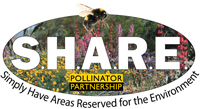Tools for S.H.A.R.E.ing
Pollinator Monitoring Data Sheet Observe wildlife activity in your farm fields, woodlands, and gardens to determine what actions you can take to encourage other pollinators to feed and nest. Evaluate the placement of individual plants and water sources and use your knowledge of specific pollinator needs to guide your choice and placement of additional plants and other habitat elements. Minor changes by many individuals can positively impact the pollinator populations in your area. Be sure to keep a record of your observations. We have provided you with an optional free to download monitoring data sheet.
Click here to download the pollinator monitoring data sheet.
Watch for - and enjoy - the changes in your landscape!
BeeSmart™ School Garden Kit This in-depth curriculum was designed to guide students in grades 3-6 through a discovery process to increase their knowledge and understanding of the connection between plants and gardening, pollinators, and food. The kit will help teachers, students, and schools S.H.A.R.E their space through the creation of native plant-based pollinator gardens.
BeeSmart™ Pollinator Gardener App This high-tech version of P2’s Ecoregional Guides helps gardeners across North America plant pollinator gardens by selecting native plants specific to each user’s location and preference (bloom color, soil type, sun exposure, etc.). This FREE app makes it easy to develop or perfect your green thumb and possible for anyone to S.H.A.R.E. space at their home or anywhere with space for a garden!
Pesticide Applicator Education P2 is dedicated to helping farmers and land managers S.H.A.R.E. Through pesticide application trainings and an upcoming film, we hope to make a difference for bees in agricultural landscapes by promoting more pollinator-friendly spraying techniques.
PINA The Pollinator Information Network of the Americas is one of six thematic networks originally established under the Inter-American Biodiversity Information Network (IABIN) (the other remaining networks being Species & Specimens; Invasive Species, Ecosystems, Protected Areas, and Geospatial).
Please click here to learn more.
DoD TER-S This research has focused on an integrated electronic database, library and gray literature search of botanical and entomological literature to associate known TER-S (Threatened, Endangered, Rare, and At Risk) plants with pollinators of these plants. Natural Resources Mangers are using this tool to effectively create S.H.A.R.E. habitat management and species recovery plans based on potential pollinators.
Ecoregional GuideThese FREE online resources are a series of beautifully illustrated guides filled with native planting information for each ecoregion of the 31 Bailey’s Ecosystem Provinces. Each has a customized plant list for the ecoregion, a list of bloom periods, and habitat hints. Specific instructions are given for farmers, public land managers and home gardeners on how they can S.H.A.R.E their spaces.
Useful Resources Search for additional pollinator resources for consumers, gardeners, resource managers, educators, farmers, and more.

